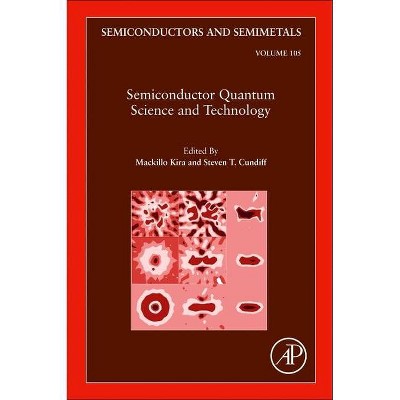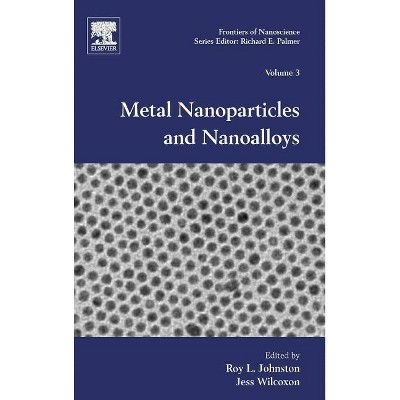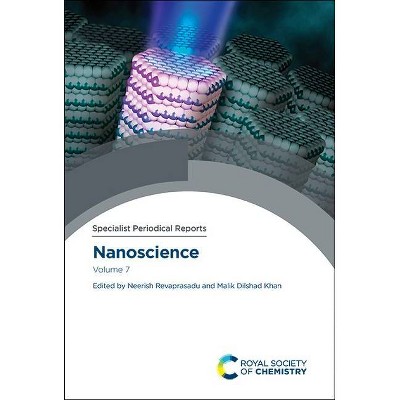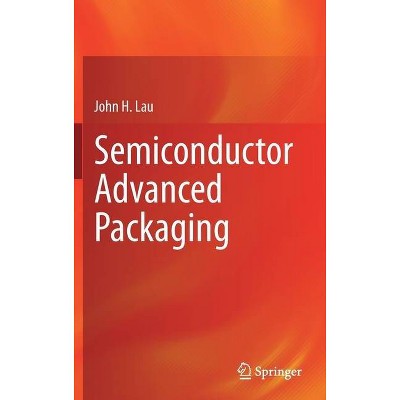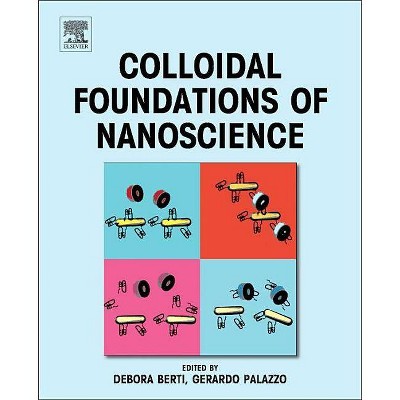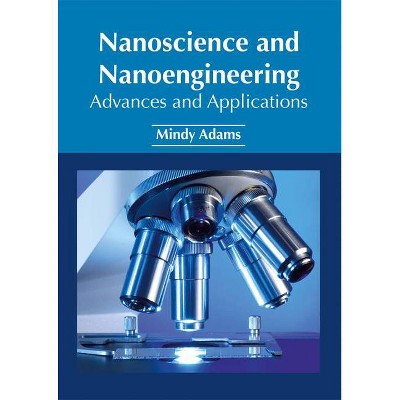Semiconductor Quantum Dots - (Nanoscience) by Mark Green (Hardcover)
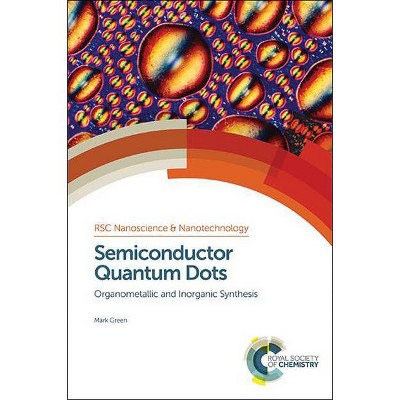
Similar Products
Products of same category from the store
AllProduct info
<p/><br></br><p><b> About the Book </b></p></br></br>Postgraduates and experienced researchers will benefit from the comprehensive nature of the book, as will manufacturers of quantum dots and those wishing to apply them.<p/><br></br><p><b> Book Synopsis </b></p></br></br><p>Quantum dots are nano-sized particles of semiconducting material, typically chalcogenides or phosphides of metals found across groups II to VI of the periodic table. Their small size causes them to exhibit unique optical and electrical properties which are now finding applications in electronics, optics and in the biological sciences.</p> <p>Synthesis of these materials began in the late 1980's and this book gives a thorough background to the topic, referencing these early discoveries. Any rapidly-expanding field will contain vast amounts of publications, and this book presents a complete overview of the field, bringing together the most relevant and seminal aspects literature in an informed and succinct manner.</p> <p>The author has been an active participant in the field since its infancy in the mid 1990's, and presents a unique handbook to the synthesis and application of this unique class of materials. Drawing on both his own experience and referencing the primary literature, Mark Green has prepared. Postgraduates and experienced researchers will benefit from the comprehensive nature of the book, as will manufacturers of quantum dots and those wishing to apply them.</p><p/><br></br><p><b> From the Back Cover </b></p></br></br><p>Quantum dots are nano-sized particles of semiconducting material, typically chalcogenides or phosphides of metals found across groups II to VI of the periodic table. Their small size causes them to exhibit unique optical and electrical properties which are now finding applications in electronics, optics and in the biological sciences.</p> <p></p> <p>Synthesis of these materials began in the late 1980's and this book gives a thorough background to the topic, referencing these early discoveries. Any rapidly-expanding field will contain vast amounts of publications, and this book presents a complete overview of the field, bringing together the most relevant and seminal aspects literature in an informed and succinct manner.</p> <p></p> <p>The author has been an active participant in the field since its infancy in the mid 1990's, and presents a unique handbook to the synthesis and application of this unique class of materials. Drawing on both his own experience and referencing the primary literature, Mark Green has prepared. Postgraduates and experienced researchers will benefit from the comprehensive nature of the book, as will manufacturers of quantum dots and those wishing to apply them.</p><p/><br></br><p><b> Review Quotes </b></p></br></br><br><p>The fi eld of nanotechnology is growing.</p> <p>The tunability of nano-objects such as</p> <p>semiconductor quantum dots (SQDs) has</p> <p>spurred interest in chemical synthesis. In</p> <p>this regard, this book's arrival is timely. It</p> <p>groups the various synthesis techniques for</p> <p>popular SQDs, comprised of 295 pages</p> <p>distributed among seven chapters and a</p> <p>comprehensive subject index. Preparation</p> <p>methods for II-VI, II-V, and IV-VI SQDs</p> <p>are described in the fi rst three chapters. The</p> <p>fi rst chapter introduces and develops various</p> <p>organometallic routes to the synthesis</p> <p>of Zn and Hg chalcogenides and anisotropic</p> <p>growth of Cd-based chalcogenides such</p> <p>as tetrapods and their alloys. Properties of</p> <p>Group III phosphides, nitrides, arsenides, </p> <p>and antimonides, which have different optical</p> <p>properties compared to II-VI semiconductors, </p> <p>are discussed in chapter 2. This</p> <p>chapter also reviews the tuning of SQD</p> <p>properties via dehalosilylation reactions</p> <p>and non-coordinating solvent routes. It</p> <p>is shown that the quantum yield can be</p> <p>increased by varying precursors and their</p> <p>quantities. Anisotropic nanoparticles with</p> <p>rod-like morphologies have also been</p> <p>examined in terms of challenges faced</p> <p>during their synthesis. Lead-based chalcogenide</p> <p>properties and synthesis routes are</p> <p>outlined in chapter 3.</p> <p>Chapter 4 deals with the synthesis of</p> <p>other chalcogenides and pnictide-based</p> <p>materials. Ternary copper-based chalcogenide</p> <p>core-shell and II3-V2 quantum dots</p> <p>include CuInSe2 and Cd3P2, respectively, </p> <p>among many others. Chapter 5 discusses</p> <p>surface passivation by means of synthesizing</p> <p>an inorganic capping layer or a core-</p> <p>shell structure. This thorough chapter is</p> <p>of fundamental and practical interest. It</p> <p>describes Type I and Type II core shells and</p> <p>multiple shell structures targeting a higher</p> <p>quantum yield. There are also sections</p> <p>relating to III-V and IV-VI core-shell</p> <p>structures. Chapter 6 unfolds ligand chemistry</p> <p>and the purpose of ligands in shaping</p> <p>the nanoparticles. Chapter 7 describes the</p> <p>role that the capping agent or the surfactant</p> <p>plays in terms of its linkable functional moieties.</p> <p>Various surfactants have been brought</p> <p>to the reader's attention, namely amines and</p> <p>thiols, among others, along with surfactant</p> <p>exchanges based upon them.</p> <p>The book also covers "green chemistry"</p> <p>synthesis aspects of SQDs and the use of</p> <p>biological molecules as capping agents, </p> <p>viz., DNA. Consideration is given to the</p> <p>toxicity of the solvents and the search for</p> <p>phosphine-free systems. Overall, the book</p> <p>is eye-catching with ample illustrations and</p> <p>interesting, as the chapter sequence is well</p> <p>conceived. Moreover, every chapter brings</p> <p>something new to the reader accompanied</p> <p>by historical facts pertaining to various</p> <p>SQD syntheses. As the book is clearly</p> <p>subtitled "synthesis" and is dedicated to</p> <p>organometallic and inorganic synthesis, it</p> <p>would be most suited to synthetic chemists.</p> <p>However, the physical properties of</p> <p>various SQDs also are well illustrated, and</p> <p>this volume is therefore of some interest to</p> <p>materials scientists and nanotechnologists.</p>--Protima Rauwel "MRS Bulletin "<br><p/><br></br><p><b> About the Author </b></p></br></br>Mark Green gained a doctorate in quantum dots from Imperial College London in 1998. . Post Doctoral work followed at Imperial College and the University of Oxford. In 2004 he joined Kings College London, becoming Senior Lecturer in 2007. His research interests include organometallic based synthesis of semiconducutor and metal nanoparticles, biological applications of nanomaterials and rare-earth based nanomaterials.
Price History
Price Archive shows prices from various stores, lets you see history and find the cheapest. There is no actual sale on the website. For all support, inquiry and suggestion messagescommunication@pricearchive.us
